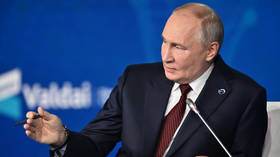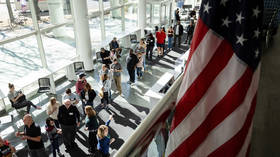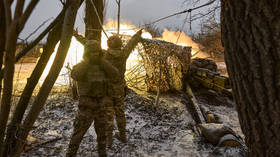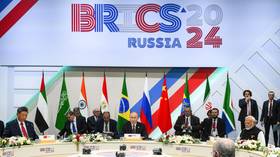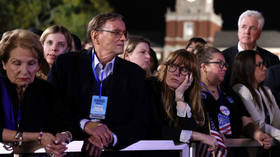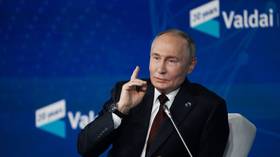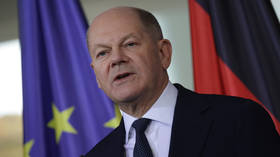Cuban flag flies in Washington as embassy reopens after 54 years
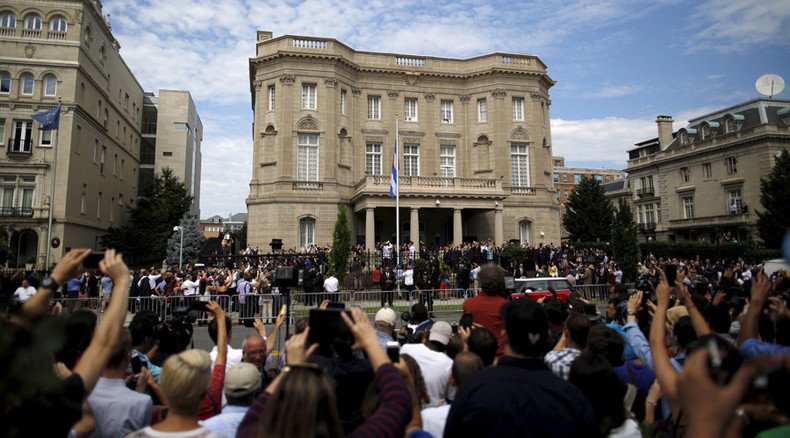
Relations between Cuba and the US took another step forward Monday as the Cuban embassy reopened in Washington and the US embassy began operations in Havana. The agreement restoring diplomatic relations came into effect at midnight last night.
Maintenance crews at the US Department of State put up the Cuban flag in the main lobby around 4am local time Monday. With the flags arranged alphabetically, Cuba assumed its rightful place between Croatia and Cyprus.
It was the first time the island nation’s banner has been displayed in the building; according to the State Department’s protocol office, the lobby was dedicated on January 5, 1961 – two days after the US broke diplomatic relations with Cuba.
#BREAKING: #Cuba flag raised in Washington DC for 1st time in 50 years as embassy reopens pic.twitter.com/s7CjG1jTJE
— Amichai Stein (@AmichaiStein1) July 20, 2015Media assembled in front of the Cuban embassy on 16th Street in Washington, DC, for the grand opening ceremony taking place at 10:30am local time. The mansion had been operating as an interests section, under the auspices of the Swiss embassy, since 1977.
La bandera cubana ya flamea en la embajada de #Cuba en Washington después de 5 décadas pic.twitter.com/X1z2pjYN2g
— Ignacio Jubilla (@Ignacio_RT) July 20, 2015Foreign Minister Bruno Rodriguez, leading the Cuban delegation to the US.
Speaking at the reception following the flag-raising, Rodriguez credited the “firm and wise leadership of Fidel Castro” and said the flag hoisted today was the same one that was taken down in 1961. It was kept safe in Florida in anticipation of this day, he said.
"As we fly again the flag that embodies the struggle of our people for national independence against the greatest challenges and dangers, we pay tribute to those who fell in defense of our nation, with absolute confidence in those who will continue to serve it with honor," Rodriguez said.
The Cuban minister also relayed a message of goodwill from President Raul Castro, who endorsed the decision to rebuild diplomatic relations based on mutual respect.
“Only the lifting of the economic, commercial and financial blockade, which has caused so much harm and suffering to our people, the return of the occupied territory Guantanamo and the respect for Cuba’s sovereignty, will lend some meaning to the event you are witnessing today,” Rodriguez said, adding that "the challenge is great because there have never been normal relations between our people."
#Cuba national anthem plays flag waves over Cuban Embassy in Washington. pic.twitter.com/c3z7xy155D
— Matt Lee (@APDiploWriter) July 20, 2015Later in the day, Rodriguez met with Secretary of State John Kerry at the State Department, the first such visit since 1958. The meeting ran long and delayed the scheduled press conference by almost an hour.
“Today we begin to repair what was damaged and to open what has been close for many years,” Kerry told reporters, calling the embassy reopening “a historic and long overdue step in the right direction.”
Though differences between the US and Cuban governments remain, the policy change reflects the reality “that the cold war ended long ago, and that interests of both countries are better served by engagement than by estrangement,” Kerry explained.
While praising the current step in rebuilding relations between the US and Cuba, Rodriguez noted that full normalization will come only when the US lifts the blockade, hands over the “illegally occupied” territory of Guantanamo Bay, and compensate Cuba for “human and economic damages” inflicted by the decades-long siege of the island nation.
Flag is up at the reopened Embassy of Cuba in #DC crowd cheering #vivaCubapic.twitter.com/nMpb4jnftS
— Paulina Leonovich (@Polly_evro) July 20, 2015Assistant Secretary of State for Western Hemisphere Affairs Roberta Jacobson and current chief of the US Interests Section in Havana Jeffrey DeLaurentis represented the US at the embassy ceremony.
The US flag will be raised at the embassy in Havana on August 14, when Secretary Kerry heads to Cuba for an official visit.
On August 14, it will be my honor to raise the American flag at our Embassy in Havana, #Cuba for 1st time in 56 years. #USCuba
— John Kerry (@JohnKerry) July 20, 2015Announcing the reopening of embassies earlier this month, President Barack Obama said the US needed to support its values through engagement, not blockade.
“We don’t have to be imprisoned by the past. If something isn’t working, we can and will change,” Obama said.
#Cuba - US embassy in Havana opens to a day 'like any other'. By @roquehabana#AFPpic.twitter.com/SrwAFeJjaM
— AFP Photo Department (@AFPphoto) July 20, 2015Speaking to reporters at the State Department Monday, the visiting Cuban minister called the relations with Washington “asymmetric,” and noted that Cuba was not blockading anyone, barring anyone’s citizens from visiting, or occupying anyone’s territory.
Still, he was optimistic about the prospect of real change in relations with the US. “We strongly believe we can both cooperate and coexist in a civilized way,” Rodriguez said.
As for questions about political changes in Cuba as a result of the normalization, he brushed them off by saying that “political opening in Cuba happened in 1959,” the year Castro’s revolutionary forces overthrew the US-backed dictatorship of Fulgencio Batista.


